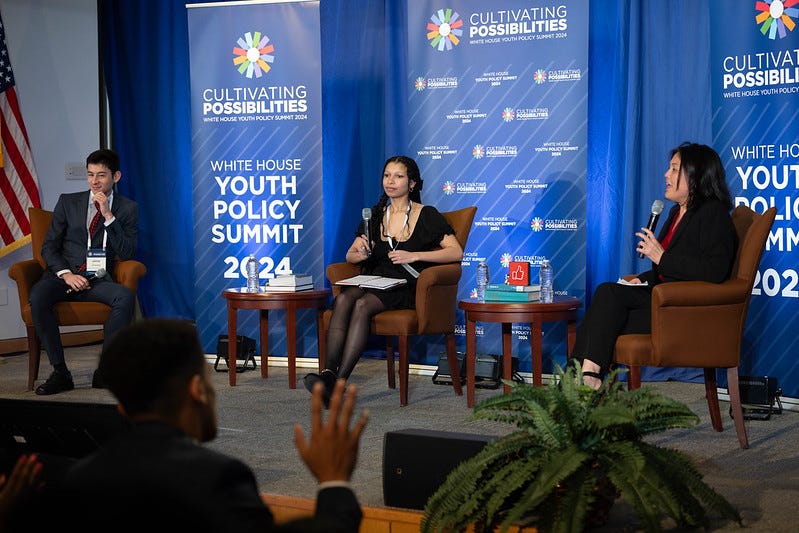Welcome back to the Education Policy Hotlist!
Thank you for reading and being a part of this community. This week's digest covers many topics, including the latest national data about students receiving special education services, a case for re-engaging business leaders in education again, the U.S. Department of Education’s first-ever youth policy summit, and new literacy resources.
Don’t forget to follow us on Instagram, Facebook, Linkedin, and Twitter!
Mark Your Calendars
Are you seeking the latest and most relevant education research and policy events? Whether you prefer to attend them virtually or in person, you can find various options on FutureEd’s events page. FutureEd is a think tank at Georgetown University’s McCourt School of Public Policy that aims to advance excellence, equity, and efficiency in education.
Don’t miss this opportunity to learn from experts, network with peers, and stay updated on the most pressing issues in education. Visit FutureEd’s events page today and register for the events that interest you.
Equity
Ethnic studies class in Parkrose School District
A Parkrose High School ethnic studies class aims to model a more just world. An Oregon student wrote a news article that discusses the efforts of their teacher and students in creating a curriculum that promotes understanding of Tribal History and its impact on broader social justice. This highlights the potential of ethnic studies classes in shaping education policy toward inclusivity and social justice.
Supreme Court to hear case on race and school admissions
The U.S. Supreme Court declined to hear a case from Virginia over race in high school admissions. Parents claimed that the admissions policy at an elite Virginia public high school racially discriminates against Asian Americans and violates the U.S. Constitution’s 14th Amendment equal protection guarantee. Yet, the justices left the lower court’s ruling rejecting this claim.
New data show disparities in access and outcomes for students with disabilities
The U.S. Department of Education’s Office for Civil Rights (OCR) released a new data snapshot that highlights the status and trends of students with disabilities in the nation’s public schools. The data show that students with disabilities represent 14% of the total student population, but they face significant gaps in access to educational opportunities and outcomes. For example, students with disabilities are more likely to be suspended, expelled, restrained, or secluded than their peers without disabilities. They are also less likely to enroll in advanced courses, graduate from high school, or pursue postsecondary education.
Quote to note: “Black students were overrepresented in the receipt of services under IDEA. Black students represented 15% of total student enrollment, but 17% of students with disabilities who received services under IDEA.”
Funding and Finance
How states could use federal funds for tutoring, advanced courses, or CTE pathways
A new piece from Education Progress suggests that states could use some federal Title funds to create a $550 million reserve for high-impact education initiatives. Such funding could benefit three areas: high-quality tutoring, advanced courses, and career and technical education (CTE) pathways. The blog provides examples of how states could design and implement these programs and the potential outcomes and costs.
An innovative approach to scheduling saves one California school district money
A case study highlights how one school district in California used a more innovative scheduling software to optimize its use of resources and staff. The district faced a fiscal cliff due to declining enrollment and rising costs and needed to find ways to save money without cutting student services. The district partnered with Timely, which helps schools create more efficient and equitable schedules. The district reduced its staffing costs by $2.2 million while maintaining its class sizes, course offerings, and student support.
Re-engaging business leaders in education
There’s a call for business leaders to re-engage in education reform. Education Next discusses the retreat of business leaders from education reform and its negative impact on both sectors. This suggests a potential shift in education policy focus, emphasizing the need for cross-sector collaboration for effective education reform.
Student Well-Being and Engagement
Addressing mental health at Worcester Polytechnic Institute
Worcester Polytechnic Institute (WPI) in Massachusetts experienced seven student deaths, at least three of which were suicides, within six months in 2022. In response to this crisis, WPI has implemented several measures, including hiring more counselors, creating social programs to help students make friends, and encouraging professors to take on the unofficial role of counselors. This highlights the urgent need for educational institutions to prioritize mental health support and create a comprehensive approach to student well-being.
Support for homeless students at risk
The $800 million in federal funding that districts across the country have relied on to cover emergency expenses for homeless students is set to run out later this year. Advocates are calling on lawmakers to extend the spending deadline for another year. This situation underscores the importance of sustainable funding for programs that support vulnerable student populations and the potential policy implications if such financing is not secured.
The Bureau of Indian Education offers a round-the-clock support line for schools and programs
The Bureau of Indian Education has launched a 24/7 support line to increase access to behavioral health and wellness support for students and staff at tribal schools nationwide. The support line is part of the bureau’s behavioral health and wellness program, which provides Indigenous-focused, evidence-based, and trauma-informed support. This initiative demonstrates a commitment to addressing mental health needs in tribal schools and could serve as a model for similar programs in other educational settings.
Education Technology
Empowering parents and teachers against tech intrusion
States are implementing policies restricting classroom cell phone use and limiting youth access to social media. These policies aim to create better learning environments and protect children from the harmful effects of excessive screen time and social media. This trend indicates a shift in education policy towards recognizing and addressing the impact of technology on student well-being and academic performance.
Did you know that … “more than 200 school districts across the United States have filed lawsuits against social media companies over the youth mental health crisis.”
Statewide longitudinal data systems
DQC released a new resource that discusses the importance of statewide longitudinal data systems (SLDSs) in improving decision-making and enabling data access. It highlights the challenges in updating SLDSs, including navigating legal frameworks, data sharing agreements, and data privacy and security requirements. This underscores the role of SLDSs in education policy, particularly in driving systemic improvements through data-driven decision-making.
Federal Policy
Biden-Harris administration hosts first-ever youth policy summit
The U.S. Department of Education and other federal agencies held this month's first-ever Interagency Youth Policy Summit. The summit brought together young leaders, policymakers, and experts to discuss the challenges and opportunities facing youth in America. The summit focused on four themes: education, health and wellness, civic engagement, and economic empowerment—the summit aimed to elevate youth voices and foster cross-agency collaboration on youth issues.
Literacy
Strong schools in D.C. and Delaware are getting their students reading
The 74 showcased how some schools in Washington, D.C., and Delaware are achieving remarkable results in literacy instruction. The report identifies four essential practices these schools share: using high-quality curriculum materials, providing intensive coaching and professional development for teachers, using data to monitor student progress and adjust instruction, and fostering a culture of joy and rigor around reading. The report also highlights the challenges and opportunities these schools face in sustaining and scaling their success.
Check out more resources about literacy instruction: Bellwether released a primer and hosted a webinar with experts. And NCTQ released their state guidance for implementing early literacy policies.
ICYMI
ExcelinEd hosted a webinar about translating the science of reading into instructional practice.
Dr. Christine Pitts is an executive leader advancing evidence-based public policy for social impact. Follow her on LinkedIn and Instagram for more updates.










